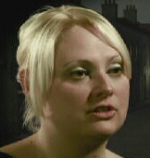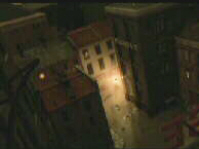Catherine Eddowes
Mitre Square
But, the Ripper had not finished his work for the night of 29 September, before morning there would be a sixth body. That of Catherine Eddowes.
By late September 1888 there had been four unsolved murders of prostitutes in Whitechapel, London. On the night of 29 September Elizabeth Stride
was found in Berner Street with her throat cut, she would be only the first of Jack the Ripper's victims that night.

Lindsay Sivitar
Lindsay Siviter Historical Researcher "Elizabeth Stride was different to the other victims in that she only had her throat cut, she had no
abdominal mutilations."
Dr Frederick Blackwell was summoned by the police from his nearby surgery.
Dr Frederick Blackwell "At about 1:10, I was called to 40 Berner Street by a policeman, where I found a woman who had been murdered. Her head had been
almost severed from her body, and in her hand she held a box of cashew. One of her hands was smeared with blood suggesting she struggled. She could not have
been dead for more than 20 minutes"
Dr Blackwell put the time of death at between 12:46 and 12:56AM.
Dr Frederick Blackwell "When the body was undressed, it was noted that there was a blueish discolouration over both shoulders, especially the right,
and under the collar bone and in front of the chest. These marks were produced by pressure from two hands."

Don Rumblelow
Don Rumblelow "Stride's death was further different in that she had been attacked from behind. She was wearing a scarf, this was pulled tight
as she was jerked backwards. The murderer, I suggest then, gripped both shoulders and bangs down the ground. This would explain the bruising on
the backs of the shoulders he could have rendered her very quickly unconscious, and then rotating the head, cut the left carotid artery which was
the method he used on the other victims and, in cutting the throat, he cuts the edge of the scarf, giving it a frayed appearance."
The following day, a key eyewitness, named Israel Schwartz, went to the police with an interpreter and gave them, possibly, the best description
that they had so far of the possible killer.
After leaving the police station, Schwartz was followed by a reporter from The Star newspaper, who tracked him to his lodgings. The Star
report contained a potentially significant, additional detail that the attacker seen by Schwartz had pushed the woman by the shoulders into
the yard. Although the passage was dark, our reconstruction of the streetlighting and reveals that Schwartz would have had a clear view of
the man's face. But, was he Jack the Ripper?
Catherine Eddowes
The fact that Elizabeth Stride was not mutilated night suggest that she was a victim of another killer. But, the reconstruction of what
happened that night suggests a far more likely explanation. That the Ripper had indeed attacked Elizabeth Stride, but had been disturbed.
The next attack would come just 40 min later on the fringes of the city of London, a little more than a mile away. Earlier that evening PC Louis
Robinson noticed a small crowd of people standing around a woman in Aldgate high Street, it was 46-year-old Catherine Eddowes. And, he arrested her
for being drunk and disorderly.
Catherine was born in Wolverhampton in 1842 one of 12 children. In 1861 Catherine became a domestic servant but then she was caught stealing and
run away and met Thomas Conway in Birmingham. We found no marriage certificate, for Thomas and Catherine, but they acted as common-law husband and
wife and had three children. In 1881 Catherine and Thomas separated, he blamed Catherine for drinking. She took up with John Kelly a labourer and
jobber at Spitalfields market.
John Kelly was interviewed by the Star on 1 November "We were thrown together, the result was, we made a regular bargain. We have lived here
ever since, as the people here will tell you."
John Kelly
When returning from hop picking in Kent, Catherine was given a pawn ticket that would ultimately lead to the identification of her mutilated
body. The hop picking had been so poor that they have returned to London penniless. She said she was going to her daughters in Bermondsey to
borrow some money, but whether that was her real intention of not is not known.
Lindsay Siviter "I don't think she had any intention of going to Bermondsey because we know that her daughter wasn't even living there any
more, but where she was going and who she is going to see, I guess we'll never know"
What we do know, is that Catherine Eddowes came face-to-face with Jack the Ripper.
In the early hours of September 30, the Ripper had already killed once but had been disturbed. Now his lust for blood was going to lead him
to kill again. Catherine Eddowes was about to be released from Bishopsgate police station. Rather than heading for her lodgings, on leaving the police
station she turned left towards Houndsditch. It would prove a fateful decision.

Mitre Square
Mitre Square, just within the boundaries of the city of London, was surrounded on all sides, mostly by tall warehouses. Poorly lit, it was
patrolled every 15 min by PC Edward Watkins. PC Watkins would later testify "It was 1:30 when I come round of Aldgate and passed around the
next corner into the square. There was nothing unusual to be seen. I turned my lantern light in every direction. I'm positive there was
nothing wrong at that time."
5 minutes later, three men leaving the Imperial club in Duke Street made an important sighting, a woman was seen talking to a man at the
entrance to church passage, the narrow alley which led into Mitre Square. Only one of the men, Joseph Lavendar, took much notice of the
couple. He described the man as of shabby appearance, about 30 years of age and 5ft 7 in height. A fair complexion, having a small fair
moustache and wearing a red neckerchief and a cap with a peak.
At 1:40 AM, PC James Harvey walked through church passage, stopping short of Mitre Square which wasn't part of his beat. Had he entered
it, he might well have seen the murder. Minutes later, PC Watkins came into the square and discovered the mutilated body of Catherine Eddowes.
Her throat had been cut to the spine and the knife had marked the cartilage in the vertebrae, and in this case, the killer had gone for further
still, leaving Eddowes face completely mutilated. The tip of her nose had been cut off and there are cuts in the eye-lids and one of the ears as
well as triangular cuts to the cheeks. The face was so badly mutilated that she could not be identified from published descriptions, and her
identity was only established when John Kelly recognised the pawn ticket given to her by Emily Birrell.
When Watkins found the body he sought help from George Morris, a night watchman who worked only a few yards away.
From what the eyewitnesses saw in and around the square that night, it's clear that the murderer must have conducted his savage attack in a
matter of minutes. And the careful reconstruction of the lighting in the square reveals that he must have acted in almost total darkness.
Dr Lars Davidsson
Dr Lars Davidsson "You could say that they were opportunistic killings, that he took a huge amount of chances, and I think that's true. I don't
think he was bothered about the possibility of being caught"
Inquest "The injuries were inflicted very quickly, however they could not have been performed in under 5 minutes. And a long pointed blade of at
least 6 inches was used"
Gareth Williams, author and researcher "The facial mutilations carried out on Catherine Eddowes where almost certainly random slashes. We know
this because Dr Dr Frederick Gordon Brown who attended the inquest noted in minute detail every single cut and slash perpetrated on her body.
Eddowes' abdomen had suffered a long zigzag cut reaching all the way from the base of the sternum down to the pelvis and it was through this
single opening that the Ripper was able to remove both the uterus and her left kidney. But, there is no reason to believe that the Ripper
simply reaching in and grabbing any object of interest and cutting it out, could have done so with no surgical training whatsoever."


